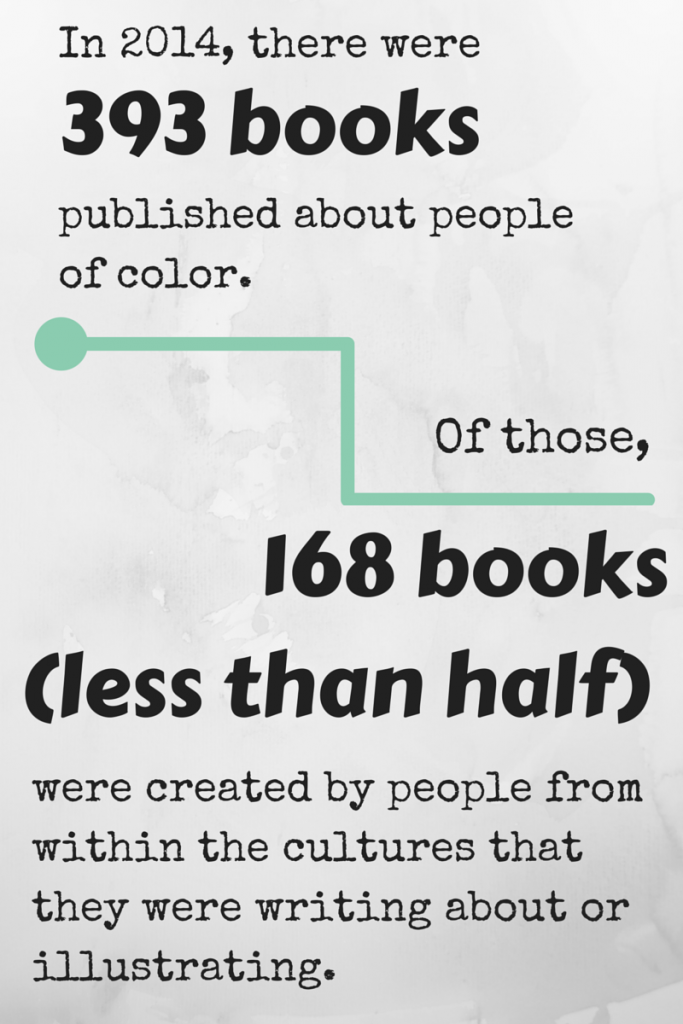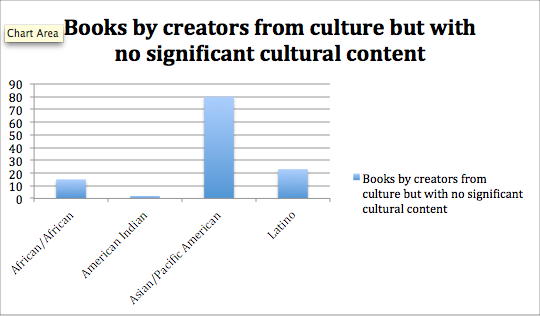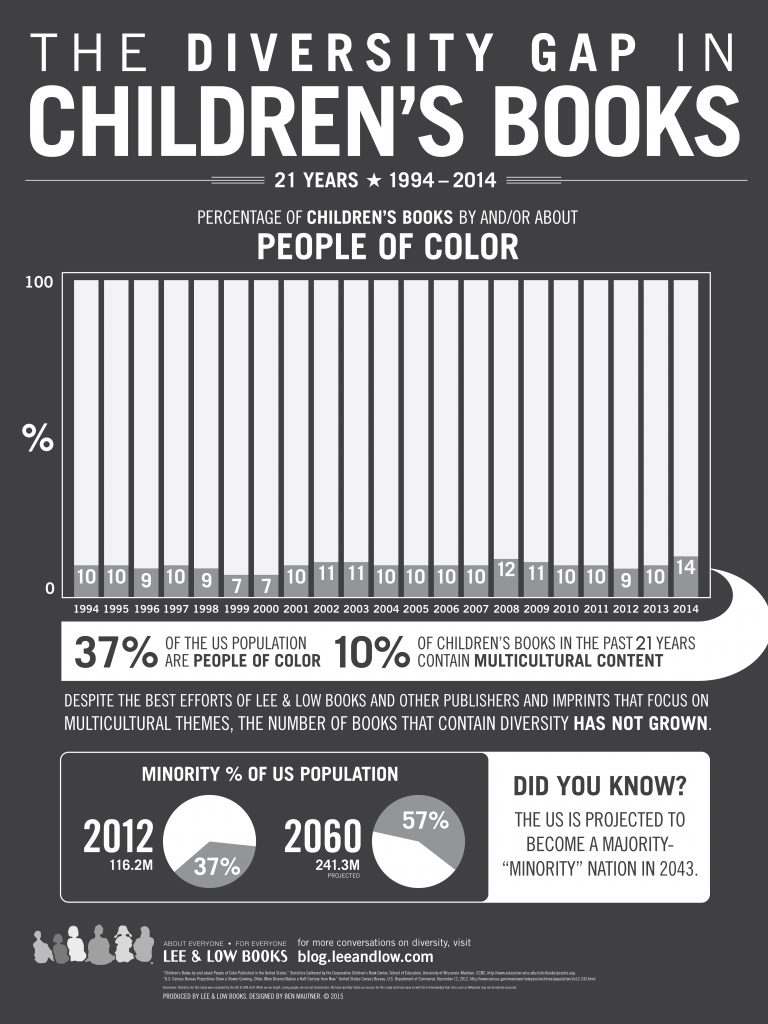This February, the Cooperative Children’s Book Center (CCBC) released its statistics on the number of children’s books by and about people of color published in 2014. The issue of diversity in children’s books received a record amount of media coverage last year, in large part due to the success of the We Need Diverse Books campaign. Many people were anxious to know if the yearly CCBC statistics would reflect momentum of the movement.
The biggest takeaway from the new statistics was positive: in 2014 the number of books by/about people of color jumped to 14% (up from 10% in 2013) of the 3,000 to 3,500 books the CCBC reviews each year. Though not as high as it should be, the number shows definite improvement.
But looking at this number alone doesn’t show the whole story. In 2012, we kicked off our infographic series with information about the diversity gap in children’s books. Here is the updated infographic, which reflects statistics through 2014:
Some observations based on the CCBC data and our infographic:
- One good year is not a guarantee of long-term change. Although the statistics for 2014 were the highest they have ever been since the CCBC started keeping track in 1994, the key question is whether or not this momentum will be maintained. The second-highest year, 2008, hit 12%, but was followed by a decrease to 11% in 2009, and then down to 10% in 2010, where it stayed until 2014. In addition, one good year does not erase 20 bad years: the total average still hovers around 10%. It will take a sustained effort to push the average above 10% and truly move the needle.
- The increase predates 2014’s big changes. The founding of We Need Diverse Books and last year’s burst of media coverage certainly brought the issue of diversity to the forefront, but they did not cause this particular increase. It takes several years to move a book from acquisition to publication. The books released in 2014 would have been acquired in 2012 or earlier—long before Walter Dean Myers’ New York Times editorial, which many credit with reigniting awareness of the diversity issue. This could mean that publishers were making a concerted effort to diversify their lists before 2014, and it was a happy accident that last year’s increase in demand coincided with an actual increase in supply. Or it could mean that 2014’s increase was just a blip on the publishing radar and not part of a larger trend.
- Creators of color are still heavily underrepresented. For the first time in 2014, the CCBC released more detailed statistics. They categorized books as “about,” “by and about,” or “by but not about” people of color. Based on those numbers, we can also calculate the number of books that are “about but not by.” The chart below compares the number of books “about but not by” people of color (blue) with the number of books “by and about” (red) people of color.

Original data taken from the Cooperative Children’s Book Center: http://ccbc.education.wisc.edu/books/2014statistics.asp
In every category except Latino, more books are being published about characters from a particular culture by someone who is not from that culture than by someone who is. This disparity is most dramatic when it comes to books with African/African American content, of which only 39% were by African Americans.
In 2014, there were 393 books published about people of color, of which 225 (57%) were by people who were not from the culture about which they wrote or which they illustrated.
It’s disconcerting that more than half the books about people of color were created by cultural outsiders. Realistically, these
 numbers likely mean that there are more white creators speaking for people of color than people of color speaking for themselves. This problem may stem from a long history in which people of color have been overlooked to tell their own stories in favor of white voices. Authors and illustrators of color have a right to be wary of an industry in which they are still underrepresented, even among books about their own cultures.
numbers likely mean that there are more white creators speaking for people of color than people of color speaking for themselves. This problem may stem from a long history in which people of color have been overlooked to tell their own stories in favor of white voices. Authors and illustrators of color have a right to be wary of an industry in which they are still underrepresented, even among books about their own cultures.This also raises questions about quality and cultural authenticity. Who is checking to make sure diverse books are culturally accurate and do not reinforce stereotypes? Are cultural consultants being routinely employed to check for accuracy? Are reviewers equipped to consider questions of cultural accuracy in reviews? Given that more diverse books are being created by cultural outsiders than insiders, these questions must be answered.
It’s worth celebrating that the number of authors and illustrators of color went up by 23% in 2014, but this does not lessen the urgent need to find ways to bring more talented creators of color into the publishing fold.
- Some authors and illustrators of color have more freedom than others. For the first time in 2014, the CCBC also released statistics citing the number of published books by creators of color that did not have significant cultural content. This statistic is a measure of the freedom that people of color have to write or illustrate topics other than their own cultures. As the numbers show, this level of freedom varies greatly from culture to culture:

Original data taken from the Cooperative Children’s Book Center: http://ccbc.education.wisc.edu/books/2014statistics.asp
Why are Asian/Pacific American creators so much more free to create books without significant cultural content? Perhaps it is because they don’t have the same pressure to create books that will be eligible for certain awards. Latino and African American authors and illustrators often work with the prospect of the Pura Belpré Award and the Coretta Scott King Award (respectively) looming over them. These awards can sell thousands of copies of a book—no small drop in the bucket, even for a major publisher. For a book to be eligible for either award, it must be both by a person from the culture and contain significant cultural content. So Latino and African American creators may feel pressured to create Belpré- or King-eligible books instead of books without cultural content. These may also be the books that publishers are most likely to acquire. While awards also exist for Asian Pacific American and Native American literature, they carry less weight in terms of sales.
Or, perhaps, Asian American creators don’t feel this freedom at all, and the numbers aren’t telling the whole story.
Conclusion: What the CCBC numbers tell us are that things are looking up, but there is a lot of work left to be done. No one set of statistics tells the whole story, but the CCBC numbers offer a baseline for tracking the progress that has been made, and shows us how far we still have to go.









